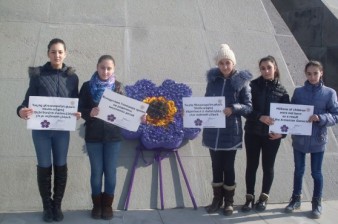
21/02/2015 20:25
Special project: “The Armenian Genocide: Breaking the Silence”. “Children on Unborn Children”
Ahead of the 100th anniversary of the Armenian Genocide, Aysor.am presents a special project whose purpose is to feature the cultural projects being carried out now.
Our interlocutor today is Nairi Mkrtchyan, editor-in-chief of the newspaper Armenians Today (Hayern Aysor) of Armenia’s Diaspora Ministry. In the run-up to the Armenian Genocide centennial, Diaspora Ministry is implementing a project entitled “Millions of babies were not born because of the Genocide”. As part of the project, children from Armenia and various countries are photographed, with the abovementioned appeal near monuments dedicated to the memory of the Armenian Genocide victims.
- Nairi, please tell us how you came up with the idea of this project.
- The idea was born through many discussions. We often speak about 1.5 million victims of the Armenian Genocide and our territorial and cultural losses. The Diaspora minister repeatedly said the number of Armenians would have increased significantly but for the loss of 1.5 million lives. So many babies could have been born…
We attempted to voice that idea. Besides, we noticed that although a number of programs were launched ahead of the Armenian Genocide, there was no program that would involve children, particularly those from around the world. After exchanging ideas, we devised such a project. Following discussions in November, we opened a Facebook page where we post pictures sent to us from Armenia and abroad.
.jpg)
- What was the reaction on the first days of the program’s implementation?
- It was Kuwait’s National School that opened the project – in other words, we received first photos from Kuwaiti kids, despite the fact that there is no monument dedicated to the Armenian Genocide there. They made a poster featuring the Tsitsernakaberd, and about 200 children with our appeal were photographed outside the school. Then Armenian schools joined the project. A total of nine countries, including Artsakh, the U.S., Australia, Lebanon, and the Netherlands have been involved so far, with the number of participants reaching 2100.
.jpg)
- Why were children chosen? Such programs also promote the struggle for the recognition and condemnation of the Genocide. How did you decide to involve children in the struggle?
- First of all, passing it down to children means that we keep the struggle alive. We have received letters from many schools. It is indicated in the letters that the project aroused a keen interest of children who are participating in it with great enthusiasm and responsibility. It has already become a method of upbringing, especially as a child sees other schools and other countries joining the project – in addition to their own school and country, and this makes the idea contagious. Besides, the posters are written in different languages, thanks to which the idea-appeal has been spreading not only among Armenian speakers, but also a lot of foreigners. And, of course, it is much more impressive when the poster expressing that idea is held by a child, rather than by an adult.
.jpg)
- Are any children from families of Genocide survivors participating in the project?
- I think that most Diaspora Armenian children involved in the project are descendants of Genocide survivors. Considering this fact, we at first intended to implement the project only in the Diaspora. Yet we realized later that it is the task of the entire Armenian nation so Armenia should be engaged as well. In Armenia, we informed regional schools via the Ministry and governors of provinces, while the Diaspora was informed through the media, with letters being sent to local Armenian centers, etc. I think we are going to receive many photos, especially in March, and their number will reach 1.5 million by April 24. The winter holidays and weather hindered the process. Besides, we initially planned that photos should be taken only near Genocide monuments, but later we realized that it would create additional difficulties, and currently it is not a mandatory condition anymore. For example, how can people with their kids travel to Genocide monuments in Syria? After what has happened, each place in Syria can be considered a monument to Genocide. For that reason, we said that kids can have their photo taken beside a monument only when occasion offers.


- Nairi, ahead of the 100th anniversary of the Armenian Genocide, we would also like to know your opinion as a citizen. There is much talk that the anniversary may become a watershed. What steps do you think our state should take and what moves can be expected from Turkey?
- I don’t think that the 100th anniversary will be a watershed since it is a problem that has no end. I think our struggle has been divided into stages, and the centennial is not the end - it may just mark the start of a new stage. We now remember and demand, and when, hopefully, Turkey accepts the reality, then we will think about further steps. In my opinion, the centennial is going to be the end of a stage, which implies the start of a new stage.
As for Turkey’s steps – if you expect Turkey to acknowledge what has happened – of course, it would be desirable, but it can hardly be expected that Turkey will be so reasonable and admit that. I am not a political scientist to make forecasts. All that I know is that we want and expect that state to be reasonable, but I don’t believe it will acknowledge the Genocide on the 100th anniversary.
As regards the project, I would like to urge all structures to assist us. It is a Pan-Armenian project and each of us should be interested in spreading its appeal.


The project was prepared with the assistance of the Information and Analytical Center of the Armenian Government Staff.
Newsfeed
Recent news of this section
12/12/2024 17:38








